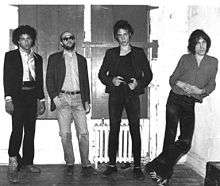Richard Hell and the Voidoids
| Richard Hell and the Voidoids | |
|---|---|
 Richard Hell and the Voidoids in 1976. Left to right: Ivan Julian, Robert Quine, Richard Hell and Marc Bell. | |
| Background information | |
| Origin | New York City, United States |
| Genres | |
| Years active | 1976–1979, 1982–1984, 1990 (Japanese tour only), 2000 (recording only) |
| Labels | |
| Associated acts | |
| Past members | See below |
Richard Hell and the Voidoids were an American punk rock band, formed in New York City in 1976 and fronted by Richard Hell, a former member of the Neon Boys, Television and the Heartbreakers.
History
Kentucky-born Richard Meyers moved to New York City after dropping out of high school in 1966, aspiring to become a poet. He and his best friend from high school, Tom Miller, founded the rock band the Neon Boys which became Television in 1973.[1] The pair adopted stage names; Miller called himself Verlaine after Paul Verlaine, a French poet he admired, and Meyers became Richard Hell because, as he has said, it described his condition.
The group was the first rock band to play the club CBGB, which soon became a breeding ground for the early punk rock scene in New York.[1] Hell had an energetic stage presence and wore torn clothing held together with safety pins and his hair spiked, which was to be influential in punk fashion[2]—in 1975, after a failed management deal with the New York Dolls, impresario Malcolm McLaren brought these ideas back with him to England and eventually incorporated them into the Sex Pistols' image.[3]
Disputes with Verlaine led to Hell's departure from Television in 1975, and he co-founded the Heartbreakers with New York Dolls guitarist Johnny Thunders. Hell did not last long with this band,[4] and he began recruiting members for a new band.[5] For guitarists, Hell found Robert Quine and Ivan Julian—Quine had worked in a bookstore with Hell, and Julian responded to an advertisement in the The Village Voice. They lifted drummer Marc Bell from Wayne County. The band was named "the Voidoids" after a novel Hell had been writing.[5]
Musically, Hell drew inspiration from acts such as Bob Dylan, the Rolling Stones, the Beatles, protopunk band the Stooges and fellow New Yorker group the Velvet Underground, a group with a reputation for heroin-fueled rock and roll with poetic lyrics.[6] Quine's admiration of the Velvet Underground led him to make hours worth of bootleg recordings of the band in the late 1960s. Hell also drew from—and covered—garage rock bands such as the Seeds and the Count Five that were found on the Nuggets compilation of 1972.[7]
Hell had written the song "Blank Generation" while still in Television; he had played it regularly with the band since at least 1975, and later with the Heartbreakers.[8] The Voidoids released a 7" Blank Generation EP in 1976 on Ork Records[5] including "Blank Generation", "Another World" and "You Gotta Lose". The cover featured a black-and-white cover photo taken by Hell's former girlfriend Roberta Bayley, depicting a bare-chested Hell with an open jeans zipper.[9] It was an underground hit, and the band signed to Sire Records for its album debut.[10]
Aside from the influential Quine, Julian and future Ramone Bell, at various times the band included Naux Maciel, Michael Allison, Jahn Xavier, former Contortions and Raybeats guitarist Jody Harris and Golden Palominos leader Anton Fier.
Legacy
The Voidoids are considered to have pioneered the "punk look" and studded appearance which also became popular later on in the UK via the Sex Pistols.[11] Sex Pistols' front man John Lydon/Johnny Rotten disputes the Voidoids influence on British punk appearance.[12]
Discography
- Studio albums
- Blank Generation (1977)
- Destiny Street (1982)
- Live albums
- Funhunt (1989)
- Singles
- "Another World"/"Blank Generation"/"You Gotta Lose" (1976)
- "Blank Generation" (1976)
- "The Kid with the Replaceable Head" (1978)
Filmography
- Blank Generation (1980)
Members
- Richard Hell – vocals, bass
- Robert Quine – guitar
- Ivan Julian – guitar
- Marc Bell (Marky Ramone) – drums
- Naux Maciel – guitar
- Frank Mauro – drums
- Michael Allison – guitar
- Jody Harris – guitar
- Fred Maher – drums
- Jahn Xavier (X Sessive) – bass
- Ted Horowitz (Popa Chubby) – bass
- James Morrison – drums
- Anton Fier – drums
- Geoff Freeman – guitar
- Charles Wood – drums
- Michael Paumgarten – guitar
References
- 1 2 Hannon 2010, p. 98.
- ↑ Finney 2012, p. 5.
- ↑ Finney 2012, pp. 47–48.
- ↑ Hannon 2010, p. 99.
- 1 2 3 Hermes 2011, p. 207.
- ↑ Finney 2012, pp. 24–29.
- ↑ Finney 2012, pp. 25–26.
- ↑ Finney 2012, p. 30.
- ↑ Balls 2014, p. 58.
- ↑ Balls 2014, p. 59.
- ↑ Mark Chapal, Malcolm McLaren (1995). Punk Culture. BBC.
- ↑ Lydon, John; Zimmerman, Keith (Oct 28, 2008). Rotten: No Irish, No Blacks, No Dogs (Reprint ed.). Picador. p. 352. ISBN 0312428138.
Sources
- Astor, Pete (2014). Richard Hell and the Voidoids' Blank Generation. Bloomsbury Publishing. ISBN 978-1-62356-856-6.
- Balls, Richard (2014). Be Stiff: The Stiff Records Story. Soundcheck Books. ISBN 978-0-9575700-6-1.
- Finney, Ross (2012-04-10). A Blank Generation: Richard Hell and American Punk Rock (PDF) (Senior thesis). University of Notre Dame. Retrieved 2014-12-24.
- Hannon, Sharon M. (2010). Punks: A Guide to an American Subculture. ABC-CLIO. ISBN 978-0-313-36456-3.
- Hermes, Will (2011). Love Goes to Buildings on Fire: Five Years in New York That Changed Music Forever. Faber and Faber. ISBN 978-1-4299-6867-6.
- Law, Glenn (2003). "Richard Hell". In Buckley, Peter. The Rough Guide to Rock. Rough Guides. pp. 485–486. ISBN 978-1-84353-105-0.
Further reading
- Hell, Richard (February 18, 2014). I Dreamed I Was a Very Clean Tramp. Ecco. ISBN 0062190849.
External links
- Richard Hell and the Voidoids discography at Discogs